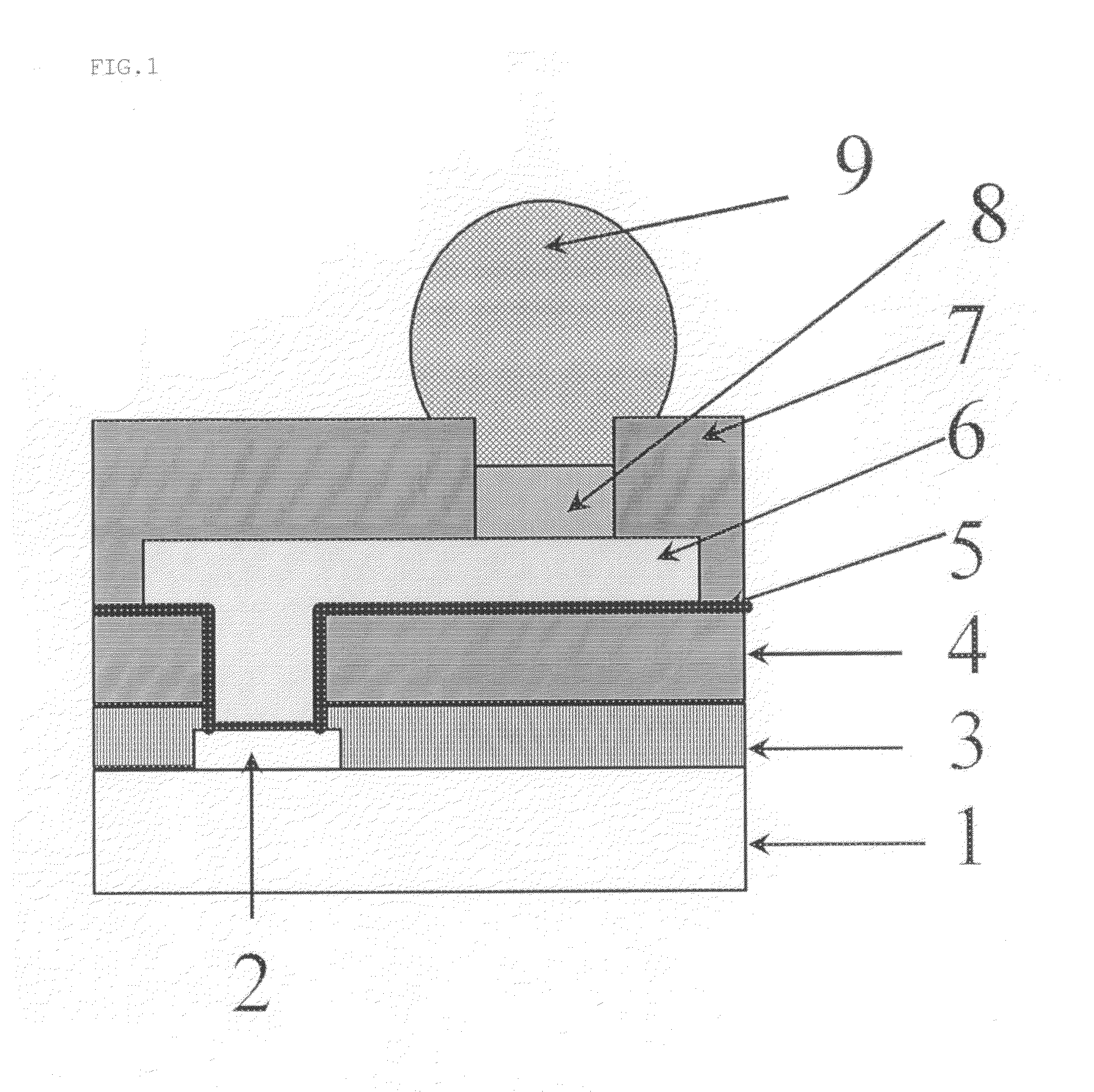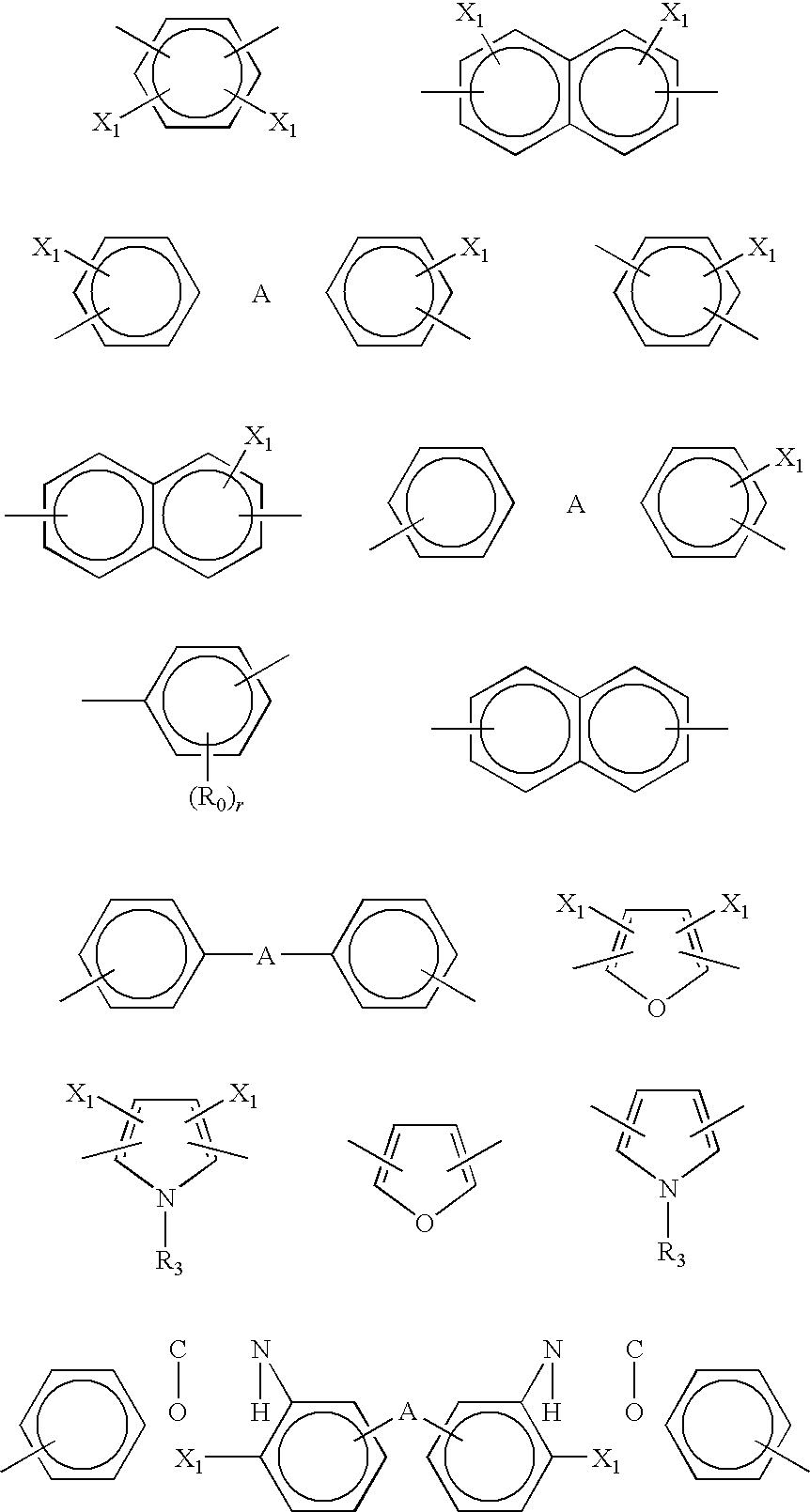Positive photosensitive resin composition, and semiconductor device and display therewith
a technology of photosensitive resin and semiconductor devices, which is applied in the direction of photosensitive materials, semiconductor/solid-state device details, instruments, etc., can solve the problems of deterioration in reflow resistance, failure to work as catalyst in cyclization step, and reliability degradation, etc., to achieve excellent reflow resistance and solvent resistance, reduce corrosion, and high reliability
- Summary
- Abstract
- Description
- Claims
- Application Information
AI Technical Summary
Benefits of technology
Problems solved by technology
Method used
Image
Examples
experimental example a1
Synthesis of a Polyamide Resin
In a four-necked separable flask equipped with a thermometer, a stirrer, a material input port and a dry nitrogen gas inlet tube were placed a mixture of dicarboxylic acid derivatives (0.016 mol) prepared by reacting 4.13 g of diphenyl ether-4,4′-dicarboxylic acid (0.016 mol) with 4.32 g of 1-hydroxy-1,2,3-benzotriazole (0.032 mol) and 7.33 g of hexafluoro-2,2-bis(3-amino-4-hydroxyphenyl)propane (0.020 mol), to which 57.0 g of N-methyl-2-pyrrolidone was added to be dissolved. Then, the mixture was reacted at 75° C. for 12 hours using an oil bath. Then, to the mixture was added 1.31 g of 5-norbornene-2,3-dicarboxylic anhydride (0.008 mol) dissolved in 7 g of N-methyl-2-pyrrolidone, and the resulting mixture was stirred for additional 12 hours for completing the reaction. After filtration of the reaction mixture, the reaction mixture was poured into a solution of water / methanol=3 / 1 (volume ratio), and the precipitate was collected by filtration, thoroughl...
experimental example a2
Synthesis of a Polyamide Resin
In a four-necked separable flask equipped with a thermometer, a stirrer, a material input port and a dry nitrogen gas inlet tube were placed 6.82 g of 4,4′-oxydiphthalic anhydride (0.022 mol), 3.26 g of 2-methyl-2-propanol (0.044 mol) and 10.9 g of pyridine (0.138 mol), to which and 150 g of N-methyl-2-pyrrolidone was added to be dissolved. Into the reaction solution was added dropwise 5.95 g of 1-hydroxy-1,2,3-benzotriazole (0.044 mol) with 30 g of N-methyl-2-pyrrolidone, and then added dropwise 22.7 g of dicyclohexylcarbodiimide (0.10 mol) with 50 g of N-methyl-2-pyrrolidone, and the mixture was reacted at room temperature overnight. Then, to this reaction solution were added 43.34 g of a dicarboxylic acid derivative (active ester) prepared by reacting 1 mol of diphenyl ether-4,4′-dicarboxylic acid with 2 mol of 1-hydroxy-1,2,3-benzotriazole (0.088 mol) and 44.7 g of hexafluoro-2,2-bis(3-amino-4-hydroxyphenyl)propane (0.122 mol) with 70 g of N-methyl-...
experimental example a3
A positive resin composition was prepared as described in Experimental Example A1 without an aluminum complex compound (d2-1). This resin composition was evaluated as described in Experimental Example A1. The evaluation results are shown in Table 1.
PUM
| Property | Measurement | Unit |
|---|---|---|
| temperature | aaaaa | aaaaa |
| temperature | aaaaa | aaaaa |
| thickness | aaaaa | aaaaa |
Abstract
Description
Claims
Application Information
 Login to View More
Login to View More - R&D
- Intellectual Property
- Life Sciences
- Materials
- Tech Scout
- Unparalleled Data Quality
- Higher Quality Content
- 60% Fewer Hallucinations
Browse by: Latest US Patents, China's latest patents, Technical Efficacy Thesaurus, Application Domain, Technology Topic, Popular Technical Reports.
© 2025 PatSnap. All rights reserved.Legal|Privacy policy|Modern Slavery Act Transparency Statement|Sitemap|About US| Contact US: help@patsnap.com



